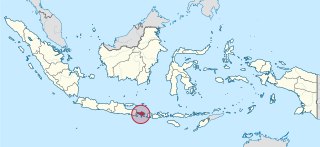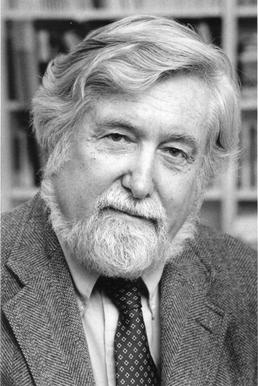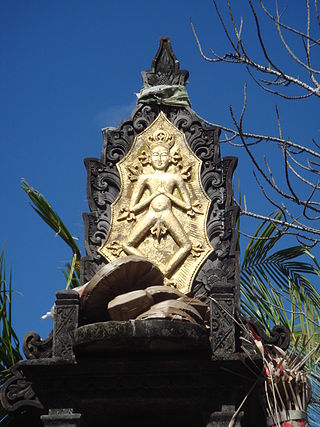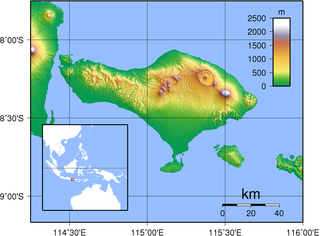Related Research Articles

Bali is a province of Indonesia and the westernmost of the Lesser Sunda Islands. East of Java and west of Lombok, the province includes the island of Bali and a few smaller offshore islands, notably Nusa Penida, Nusa Lembongan, and Nusa Ceningan to the southeast. The provincial capital, Denpasar, is the most populous city in the Lesser Sunda Islands and the second-largest, after Makassar, in Eastern Indonesia. The upland town of Ubud in Greater Denpasar is considered Bali's cultural centre. The province is Indonesia's main tourist destination, with a significant rise in tourism since the 1980s. Tourism-related business makes up 80% of its economy.

Trance and Dance in Bali is a short documentary film shot by the anthropologists Margaret Mead and Gregory Bateson during their research on Bali in the 1930s. It shows female dancers with sharp kris daggers dancing in trance, eventually stabbing themselves without injury. The film was not released until 1951. It has attracted praise from later anthropologists for its pioneering achievement, and criticism for its focus on the performance, omitting relevant details such as the conversation of the dancers.

Clifford James Geertz was an American anthropologist who is remembered mostly for his strong support for and influence on the practice of symbolic anthropology and who was considered "for three decades... the single most influential cultural anthropologist in the United States." He served until his death as professor emeritus at the Institute for Advanced Study, Princeton.

The Balinese people are an Austronesian ethnic group native to the Indonesian island of Bali. The Balinese population of 4.2 million live mostly on the island of Bali, making up 89% of the island's population. There are also significant populations on the island of Lombok and in the easternmost regions of Java.

Timothy Asch was an American anthropologist, photographer, and ethnographic filmmaker. Along with John Marshall and Robert Gardner, Asch played an important role in the development of visual anthropology. He is particularly known for his film The Ax Fight and his role with the USC Center for Visual Anthropology.
The Margaret Mead Film Festival is an annual film festival held at the American Museum of Natural History in New York City. It is the longest-running, premiere showcase for international documentaries in the United States, encompassing a broad spectrum of work, from indigenous community media to experimental nonfiction. The Festival is distinguished by its outstanding selection of titles, which tackle diverse and challenging subjects, representing a range of issues and perspectives, and by the forums for discussion with filmmakers and speakers.
Kata Kolok, also known as Benkala Sign Language and Balinese Sign Language, is a village sign language which is indigenous to two neighbouring villages in northern Bali, Indonesia. The main village, Bengkala, has had high incidences of deafness for over seven generations. Notwithstanding the biological time depth of the recessive mutation that causes deafness, the first substantial cohort of deaf signers did not occur until five generations ago, and this event marks the emergence of Kata Kolok. The sign language has been acquired by at least five generations of deaf, native signers and features in all aspects of village life, including political, professional, educational, and religious settings.
A Balinese Trance Seance is a 1979 documentary film by ethnographic filmmaker Tim Asch and anthropologist Linda Connor that profiles Jero Tapakan, a Balinese spirit medium. It was one of five films that were made with Jero Tapakan and were considered to be exemplary ethnographic films.

Achintya, also known as Sang Hyang Widhi Wasa and Sang Hyang Tunggal, is the Supreme God of Indonesian Hinduism, especially on the island of Bali. Achintya is equivalent to the metaphysical concept of Brahman of Indian Hinduism, and is the Supreme God in traditional wayang theatre. All gods, goddesses and existence are believed to be the manifestation of the Achintya in Balinese Hinduism.
The Coral Bell School of Asia Pacific Affairs is a constituent of the College of Asia and the Pacific, but was formerly part of the Research School of Pacific and Asian Studies, ANU, which was founded in 1946 as part of the Institute of Advanced Studies at the Australian National University in Canberra, Australian Capital Territory. In 2015 it was renamed in honour of Coral Bell, a leading Australian scholar of international politics.
Robert Bush Lemelson is an American cultural anthropologist and film producer. He received his M.A. from the University of Chicago and Ph.D. from the Department of Anthropology at the University of California, Los Angeles. Lemelson's area of specialty is transcultural psychiatry; Southeast Asian Studies, particularly Indonesia; and psychological and medical anthropology. He is a research anthropologist in the Semel Institute of Neuroscience UCLA, and an adjunct professor of Anthropology at UCLA. His scholarly work has appeared in journals and books. Lemelson founded Elemental Productions in 2008, a documentary production company, and has directed and produced numerous ethnographic films.

Negara: The Theatre State in Nineteenth-Century Bali is a 1980 book written by anthropologist Clifford Geertz. Geertz argues that the pre-colonial Balinese state was not a "hydraulic bureaucracy" nor an oriental despotism, but rather, an organized spectacle. The noble rulers of the island were less interested in administering the lives of the Balinese than in dramatizing their rank and hence political superiority through large public rituals and ceremonies. These cultural processes did not support the state, he argues, but were the state.
It is perhaps most clear in what was, after all, the master image of political life: kingship. The whole of the negara - court life, the traditions that organized it, the extractions that supported it, the privileges that accompanied it - was essentially directed toward defining what power was; and what power was what kings were. Particular kings came and went, 'poor passing facts' anonymized in titles, immobilized in ritual, and annihilated in bonfires. But what they represented, the model-and-copy conception of order, remained unaltered, at least over the period we know much about. The driving aim of higher politics was to construct a state by constructing a king. The more consummate the king, the more exemplary the centre. The more exemplary the centre, the more actual the realm.
Mangku Muriati is a traditional-style Balinese painter and priestess from Kamasan village near Klungkung, Bali, Indonesia.
The 1976 Bali earthquake occurred at 15:13 local time on 14 July with a surface wave magnitude of 6.5. The shock occurred 5 kilometres (3.1 mi) south of the Bali Sea coast of the Buleleng Regency, and about 65 kilometres (40 mi) northwest of Denpasar. Up to ninety percent of houses in Buleleng Regency were seriously damaged or destroyed and the Seririt sub-district was almost completely destroyed, where a school building collapsed and trapped at least 200 students. 573 people are believed to have died; at least 544 in Buleleng Regency, 24 in Jembrana and 5 in Tabanan. Four thousand more suffered injuries and an estimated 450,000 were left temporarily homeless.

J. Stephen Lansing is an American anthropologist and complexity scientist. He is especially known from his decades of research on the emergent properties of human-environmental interactions in Bali, Borneo and the Malay Archipelago; social-ecological modeling, and complex adaptive systems. He is an external professor at the Santa Fe Institute and the Complexity Science Hub Vienna; a Fellow at the Center for Advanced Study in the Behavioral Sciences at Stanford; a visiting scholar at the Hoffman Global Institute for Business and Society at INSEAD Singapore, and emeritus professor of anthropology at the University of Arizona.
James Joseph Fox is an American anthropologist and historian of Indonesia.

I Wayan Arka is an Indonesian-Balinese linguist, lecturer, scholar and researcher at Udayana University (UNUD) in Bali, Indonesia and the Australian National University (ANU) in Canberra, Australia.
Hildred Storey Geertz was an American anthropologist who studied Balinese and Javanese kinship practices and Balinese art in Indonesia.
References
- ↑ "Academy Fellow: Professor Linda Connor ASSA". Academy of the Social Sciences in Australia. Retrieved 5 October 2020.
- ↑ Sydney, The University of. "Professor Linda Connor - The University of Sydney". sydney.edu.au.
- ↑ "Officers - University of Sydney". www.nteu.org.au. Retrieved 6 May 2019.
- ↑ Connor, Linda H. (1995). "The Action of the Body on Society: Washing a Corpse in Bali". The Journal of the Royal Anthropological Institute. 1 (3): 537–559. doi:10.2307/3034574. ISSN 1359-0987. JSTOR 3034574.
- ↑ Connor, Linda H. (2004). "Relief, risk and renewal: mixed therapy regimens in an Australian suburb". Social Science & Medicine. 59 (8): 1695–1705. doi:10.1016/j.socscimed.2004.01.030. ISSN 0277-9536. PMID 15279926.
- ↑ Mcmanus, Phil; Connor, Linda H (2013). "What's Mine Is Mine(D): Contests Over Marginalisation Of rural life in the Upper Hunter, NSW". Rural Society. 22 (2): 166–183. doi:10.5172/rsj.2013.22.2.166. ISSN 1037-1656. S2CID 109486459.
- ↑ Connor, Linda; Asch, Patsy (1995). "Subjects, Images, Voices: Representing Gender in Ethnographic Film". Visual Anthropology Review. 11 (1): 5–18. doi:10.1525/var.1995.11.1.5.
- ↑ Connor, Linda H. (1995). "Acquiring invisible strength: A Balinese discourse of harm and well‐being". Indonesia Circle. School of Oriental & African Studies. Newsletter. 23 (66): 124–153. doi:10.1080/03062849508729843. ISSN 0306-2848.
- ↑ Connor, Linda; Higginbotham, Nick; Freeman, Sonia; Albrecht, Glenn (2008). "Watercourses and Discourses: Coalmining in the Upper Hunter Valley, New South Wales". Oceania. 78 (1): 76–90. doi:10.1002/j.1834-4461.2008.tb00029.x. hdl: 1959.13/40190 . ISSN 0029-8077.
- ↑ Rubinstein, R; Connor, L (1999). Staying Local in the Global Village: Bali in the Twentieth Century. Honolulu: University of Hawaii Press. ISBN 9780824821173. JSTOR j.ctt6wr0k5.
- ↑ Connor, L; Vickers, A (2003). "Crisis, citizenship, and cosmopolitanism: Living in a local and global risk society in Bali". Indonesia. 75 (75): 153–180. JSTOR 3351311.
- ↑ Asch, P., Asch. T., and Connor, L. 1981. Jero on Jero. 'A Balinese Trance Seance' Observed. Dist.: Documentary Educational Resources (DER), Royal Anthropological Institute and ANU (RSPAS), Canberra.
- ↑ Asch, P., Connor, L., and Asch. T. 1983. Jero Tapakan: Stories from the life of a Balinese healer. ANU, Canberra.
- ↑ Asch, P., Asch. T., and Connor, L. 1983. The Medium is the Masseuse . Dist.: DER, Royal Anthropological Institute and ANU (RSPAS), Canberra.
- ↑ Asch, P., Asch. T., and Connor, L. 1991. Releasing the Spirits: A Village Cremation in Bali. Dist.: DER, Royal Anthropological Institute and ANU (RSPAS), Canberra.
- ↑ Connor, L. and Samuel, G. (eds.) 2001. Healing Powers and Modernity: Shamanism, Science and Traditional Medicine in Asian Societies. Westport, CT: Bergin and Garvey. 283pp
- ↑ Connor, Linda H. (2016). "Energy futures, state planning policies and coal mine contests in rural New South Wales". Energy Policy. 99: 233–241. doi:10.1016/j.enpol.2016.05.026.
- ↑ "Home". The Coal Rush and Beyond.
- ↑ "ARC Project ID: DP180101368". 2019.